During the great recession the auto industry was effectively restructured with two of the three auto makers being taken over by the government with bondholders and shareholders being effectively wiped out. Ford, and the two restructured auto companies (GM and Chrysler), are now facing new challenges and the future of the US auto industry is likely to be very different from its current state. This article will focus on how the auto industry arrived at this position and where it will likely head in the future as a result.
The Auto Industry in the United States
As the inventor of the automobile, US manufacturers had a significant head start on international competition and maintained dominance in the industry throughout the 50’s and 60’s. Ford had developed production line facilities and had decreased the cost of automobiles so that most Americans could afford them. American made automobiles dominated the industry and were highly regarded by critics and consumers.
In the 70’s, competition started to spring up from Japan which produced cheaper vehicles that had lower costs and very low profit margins. The US automakers ignored this low-end segment of the market and eventually these Japanese auto makers innovated, improved the quality of their vehicles, and began to increase their sales. Over a period of time, the US automakers experienced a decline in sales as a percentage of the market. US automakers attempted to revitalize their companies by innovating but were hamstrung by legacy pension costs that limited their ability to compete. The government takeover eliminated many of these concerns by negotiating with the unions and eventually making changes to these legacy pension liabilities.
Adjustments for the Future
Two of the three auto makers therefore start out with a semi-clean slate and room to innovate as a result of the removal of these legacy liabilities. These automakers are generally making future plans to coincide with two of the larger macro trends that are expected to continue into the future; increased globalization and higher energy costs.
Globalization has been caused by increased connectivity between the world and has impacted how business operate, as well as led to a shifting of resources around the world. US automakers have been increasingly locating their auto manufacturing plants overseas to capture lower labor costs and this trend is expected to continue in future years. Further, developing countries such as China and India have been increasingly purchasing cars and vehicles are now being designed to capture the desires and needs of these market segments. Auto makers have been accommodating global demand by making cars smaller and are expected to bring out models that are further catered to international tastes in the future.
Higher energy costs are also expected to impact US automakers in the future with gas-powered vehicles being built with lighter construction materials to improve gas mileage. Further, as consumers are more and more concerned with gas mileage and the impact that their auto usage may have on the planet, US auto makers are attempting to move towards this shift in consumer taste by modifying their fleets further. Renewable energy is expected to play a part with a move towards battery operated cars or vehicles that use hybrid sources of energy.
Conclusion
Automakers in the US have experienced major headwinds in the past due to increased competition and changing consumer tastes. While US automakers have been caught flat-footed in the past, they appear to be ready for shifting global tastes by presenting vehicles that meet more globalized tastes and ecological concerns. The success of the US auto industry will likely result from how these factors are addressed in coming years.
Image License All rights reserved by UKinUSA



